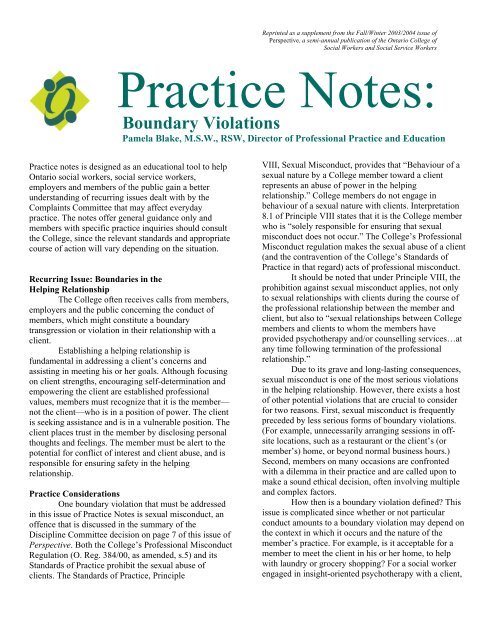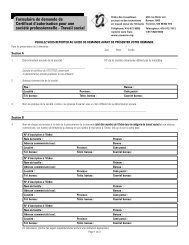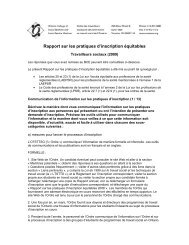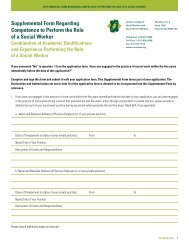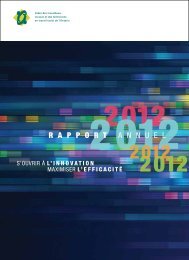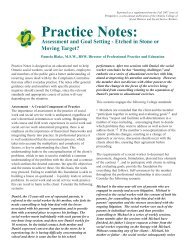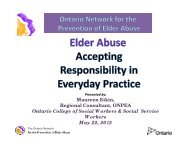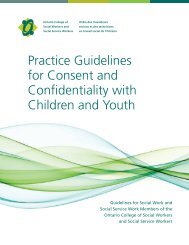Boundary Violations - Ontario College of Social Workers and Social ...
Boundary Violations - Ontario College of Social Workers and Social ...
Boundary Violations - Ontario College of Social Workers and Social ...
Create successful ePaper yourself
Turn your PDF publications into a flip-book with our unique Google optimized e-Paper software.
Reprinted as a supplement from the Fall/Winter 2003/2004 issue <strong>of</strong><br />
Perspective, a semi-annual publication <strong>of</strong> the <strong>Ontario</strong> <strong>College</strong> <strong>of</strong><br />
<strong>Social</strong> <strong>Workers</strong> <strong>and</strong> <strong>Social</strong> Service <strong>Workers</strong><br />
Practice Notes:<br />
<strong>Boundary</strong> <strong>Violations</strong><br />
Pamela Blake, M.S.W., RSW, Director <strong>of</strong> Pr<strong>of</strong>essional Practice <strong>and</strong> Education<br />
Practice notes is designed as an educational tool to help<br />
<strong>Ontario</strong> social workers, social service workers,<br />
employers <strong>and</strong> members <strong>of</strong> the public gain a better<br />
underst<strong>and</strong>ing <strong>of</strong> recurring issues dealt with by the<br />
Complaints Committee that may affect everyday<br />
practice. The notes <strong>of</strong>fer general guidance only <strong>and</strong><br />
members with specific practice inquiries should consult<br />
the <strong>College</strong>, since the relevant st<strong>and</strong>ards <strong>and</strong> appropriate<br />
course <strong>of</strong> action will vary depending on the situation.<br />
Recurring Issue: Boundaries in the<br />
Helping Relationship<br />
The <strong>College</strong> <strong>of</strong>ten receives calls from members,<br />
employers <strong>and</strong> the public concerning the conduct <strong>of</strong><br />
members, which might constitute a boundary<br />
transgression or violation in their relationship with a<br />
client.<br />
Establishing a helping relationship is<br />
fundamental in addressing a client’s concerns <strong>and</strong><br />
assisting in meeting his or her goals. Although focusing<br />
on client strengths, encouraging self-determination <strong>and</strong><br />
empowering the client are established pr<strong>of</strong>essional<br />
values, members must recognize that it is the member—<br />
not the client—who is in a position <strong>of</strong> power. The client<br />
is seeking assistance <strong>and</strong> is in a vulnerable position. The<br />
client places trust in the member by disclosing personal<br />
thoughts <strong>and</strong> feelings. The member must be alert to the<br />
potential for conflict <strong>of</strong> interest <strong>and</strong> client abuse, <strong>and</strong> is<br />
responsible for ensuring safety in the helping<br />
relationship.<br />
Practice Considerations<br />
One boundary violation that must be addressed<br />
in this issue <strong>of</strong> Practice Notes is sexual misconduct, an<br />
<strong>of</strong>fence that is discussed in the summary <strong>of</strong> the<br />
Discipline Committee decision on page 7 <strong>of</strong> this issue <strong>of</strong><br />
Perspective. Both the <strong>College</strong>’s Pr<strong>of</strong>essional Misconduct<br />
Regulation (O. Reg. 384/00, as amended, s.5) <strong>and</strong> its<br />
St<strong>and</strong>ards <strong>of</strong> Practice prohibit the sexual abuse <strong>of</strong><br />
clients. The St<strong>and</strong>ards <strong>of</strong> Practice, Principle<br />
VIII, Sexual Misconduct, provides that “Behaviour <strong>of</strong> a<br />
sexual nature by a <strong>College</strong> member toward a client<br />
represents an abuse <strong>of</strong> power in the helping<br />
relationship.” <strong>College</strong> members do not engage in<br />
behaviour <strong>of</strong> a sexual nature with clients. Interpretation<br />
8.1 <strong>of</strong> Principle VIII states that it is the <strong>College</strong> member<br />
who is “solely responsible for ensuring that sexual<br />
misconduct does not occur.” The <strong>College</strong>’s Pr<strong>of</strong>essional<br />
Misconduct regulation makes the sexual abuse <strong>of</strong> a client<br />
(<strong>and</strong> the contravention <strong>of</strong> the <strong>College</strong>’s St<strong>and</strong>ards <strong>of</strong><br />
Practice in that regard) acts <strong>of</strong> pr<strong>of</strong>essional misconduct.<br />
It should be noted that under Principle VIII, the<br />
prohibition against sexual misconduct applies, not only<br />
to sexual relationships with clients during the course <strong>of</strong><br />
the pr<strong>of</strong>essional relationship between the member <strong>and</strong><br />
client, but also to “sexual relationships between <strong>College</strong><br />
members <strong>and</strong> clients to whom the members have<br />
provided psychotherapy <strong>and</strong>/or counselling services…at<br />
any time following termination <strong>of</strong> the pr<strong>of</strong>essional<br />
relationship.”<br />
Due to its grave <strong>and</strong> long-lasting consequences,<br />
sexual misconduct is one <strong>of</strong> the most serious violations<br />
in the helping relationship. However, there exists a host<br />
<strong>of</strong> other potential violations that are crucial to consider<br />
for two reasons. First, sexual misconduct is frequently<br />
preceded by less serious forms <strong>of</strong> boundary violations.<br />
(For example, unnecessarily arranging sessions in <strong>of</strong>fsite<br />
locations, such as a restaurant or the client’s (or<br />
member’s) home, or beyond normal business hours.)<br />
Second, members on many occasions are confronted<br />
with a dilemma in their practice <strong>and</strong> are called upon to<br />
make a sound ethical decision, <strong>of</strong>ten involving multiple<br />
<strong>and</strong> complex factors.<br />
How then is a boundary violation defined This<br />
issue is complicated since whether or not particular<br />
conduct amounts to a boundary violation may depend on<br />
the context in which it occurs <strong>and</strong> the nature <strong>of</strong> the<br />
member’s practice. For example, is it acceptable for a<br />
member to meet the client in his or her home, to help<br />
with laundry or grocery shopping For a social worker<br />
engaged in insight-oriented psychotherapy with a client,
Reprinted as a supplement from the Fall/Winter 2003/2004 issue <strong>of</strong><br />
Perspective, a semi-annual publication <strong>of</strong> the <strong>Ontario</strong> <strong>College</strong> <strong>of</strong><br />
<strong>Social</strong> <strong>Workers</strong> <strong>and</strong> <strong>Social</strong> Service <strong>Workers</strong><br />
this would be inappropriate. For a social service worker<br />
employed on an Assertive Community Treatment team,<br />
whose client has a severe <strong>and</strong> persistent mental illness,<br />
this would be acceptable conduct provided that it is <strong>of</strong><br />
therapeutic benefit to the client <strong>and</strong> within the scope <strong>of</strong><br />
the social worker’s or social service worker’s contract<br />
with the client. It is critical at the outset to make explicit<br />
to the client the boundaries <strong>of</strong> the relationship. The onus<br />
then is on the member to ensure that those boundaries<br />
are maintained.<br />
Boundaries define the set <strong>of</strong> roles <strong>and</strong><br />
expectations for the member <strong>and</strong> client, <strong>and</strong> establish<br />
ground rules for their work together. These principles are<br />
reflected in the following St<strong>and</strong>ards <strong>of</strong> Practice:<br />
Principle I, Relationship with Clients<br />
1.1 <strong>College</strong> members <strong>and</strong> clients participate together in<br />
setting <strong>and</strong> evaluating goals. A purpose for the<br />
relationship between <strong>College</strong> members <strong>and</strong> clients is<br />
identified.<br />
Principle II, Competence <strong>and</strong> Integrity<br />
<strong>College</strong> members establish <strong>and</strong> maintain clear <strong>and</strong><br />
appropriate boundaries in pr<strong>of</strong>essional relationships for<br />
the protection <strong>of</strong> clients.<br />
To determine appropriate boundaries, it may be<br />
helpful to view boundary transgressions on a continuum<br />
from those which likely pose little risk <strong>of</strong> harm to the<br />
client, to those which pose a major risk to the client,<br />
including lasting or permanent damage (such as suicidal<br />
behaviour or completed suicide).<br />
The least harmful end <strong>of</strong> the spectrum may be<br />
called a boundary crossing or a digression from usual<br />
practice. An example <strong>of</strong> this is a client giving the<br />
member a small gift. Should the member accept it A<br />
number <strong>of</strong> factors need to considered: What are the<br />
circumstances under which the gift given – at the<br />
termination <strong>of</strong> the helping relationship In response to a<br />
difficult session in which there was conflict between<br />
member <strong>and</strong> client The intent <strong>of</strong> the client in <strong>of</strong>fering a<br />
gift needs to be understood. (For example, is the gesture<br />
<strong>of</strong> thanks, or is it motivated by a fear <strong>of</strong> rejection by the<br />
member) The value also must be considered – is the gift<br />
a h<strong>and</strong>crafted glasses case, made by the client, or a set <strong>of</strong><br />
tickets prime location for a major league baseball game<br />
Exploring the gift-giving by the client can reveal<br />
important information, which can be used constructively<br />
in the helping relationship. Cultural influences <strong>and</strong> how<br />
<strong>of</strong>ten a client <strong>of</strong>fers also should be considered.<br />
Ultimately, the member must judge whether the client<br />
will be helped by accepting the gift or whether this could<br />
put the client at risk in any way. The member also must<br />
be aware <strong>of</strong> any policies set by their employer about<br />
accepting gifts from clients <strong>and</strong> respond accordingly. As<br />
well, members in private practice may wish to develop<br />
their own policies regarding gifts.<br />
Other dilemmas may arise when a client makes a<br />
request the member knows is a boundary crossing. For<br />
example, a client asks the member to sponsor her in a<br />
walk-a-thon to raise funds for AIDS research. In this, as<br />
in other situations, the context <strong>of</strong> the request needs to be<br />
considered. The work with the client has centred on<br />
helping her come to terms with the death <strong>of</strong> her brother<br />
from AIDS <strong>and</strong> her difficulty accepting his lifestyle. Her<br />
decision to participate in the walk-a-thon represents<br />
significant resolution <strong>of</strong> her conflicted feelings <strong>and</strong> her<br />
desire to demonstrate this to the member. Having<br />
understood the meaning <strong>of</strong> the client’s request, a<br />
judgment must be made. Assuming that the request is<br />
practically feasible, does agreeing to sponsor the client<br />
pose any risks What would be the impact <strong>of</strong> agreeing<br />
Refusing Both the decision <strong>and</strong> the rationale need to be<br />
discussed with the client.<br />
Another dilemma encountered by members is<br />
the request by a client to see his or her friend or relative<br />
in counselling or psychotherapy. One perspective is that<br />
the risks are so high that this should never be agreed to.<br />
Indeed the safest route would be to decline. However,<br />
there may be circumstances that warrant consideration <strong>of</strong><br />
this request. In locations where resources are limited, or<br />
the member specializes in a particular kind <strong>of</strong> work,<br />
refusing may mean that the person does not receive<br />
badly needed assistance.<br />
However, in addition to the issue <strong>of</strong> boundary<br />
violations this dilemma gives rise to a host <strong>of</strong> other<br />
issues which require meticulous scrutiny. Among these<br />
is conflict <strong>of</strong> interest (2.2.1): “<strong>College</strong> members do not<br />
engage in pr<strong>of</strong>essional relationships that constitute a<br />
conflict <strong>of</strong> interest or in situations in which members<br />
ought reasonably to have known that the client would be<br />
at risk in any way. <strong>College</strong> members avoid or declare<br />
conflict <strong>of</strong> interest situations. <strong>College</strong> members do not<br />
provide a pr<strong>of</strong>essional service to the client while the<br />
member is in a conflict <strong>of</strong> interest.” The member must<br />
be careful to make a decision not based on financial<br />
considerations or feeling flattered that their work has<br />
been affirmed. Members also are reminded <strong>of</strong> st<strong>and</strong>ard<br />
1.6: “<strong>College</strong> members distinguish their needs <strong>and</strong><br />
interests from those <strong>of</strong> their clients to ensure that, within<br />
pr<strong>of</strong>essional relationships, clients’ needs <strong>and</strong> interests<br />
remain paramount.”<br />
Entering into a pr<strong>of</strong>essional relationship with the<br />
friend or relative <strong>of</strong> a client also raises the issue <strong>of</strong> dual<br />
relationship. St<strong>and</strong>ard 3.7 is relevant to this: “<strong>College</strong><br />
members avoid conflicts <strong>of</strong> interest <strong>and</strong>/or dual
Reprinted as a supplement from the Fall/Winter 2003/2004 issue <strong>of</strong><br />
Perspective, a semi-annual publication <strong>of</strong> the <strong>Ontario</strong> <strong>College</strong> <strong>of</strong><br />
<strong>Social</strong> <strong>Workers</strong> <strong>and</strong> <strong>Social</strong> Service <strong>Workers</strong><br />
relationships with clients or former clients, or with<br />
students, employees <strong>and</strong> supervisees that could impair<br />
members’ pr<strong>of</strong>essional judgment or increase the risk <strong>of</strong><br />
exploitation or harm to clients.” In this regard it should<br />
be considered whether the request is coming from a<br />
current or former client. If from a former client, how<br />
recent was the contact <strong>and</strong> might the client at any time<br />
wish to return to see the member If a current or recently<br />
terminated client, a member would be strongly advised<br />
against seeing a friend or relative. The nature <strong>of</strong> the<br />
relationship between the client <strong>and</strong> potential client<br />
should be considered. It also may be necessary for the<br />
member to determine whether he or she already has<br />
formed an opinion <strong>of</strong> the potential client based on the<br />
client’s perspective. How would the member keep in<br />
check his or her own reactions to both clients Only if a<br />
member can truly declare that their pr<strong>of</strong>essional<br />
judgment would not be unduly affected <strong>and</strong> that risks to<br />
the client are minimal should seeing a friend or relative<br />
<strong>of</strong> a client be given any further consideration.<br />
The issue <strong>of</strong> confidentiality also is paramount. In<br />
accordance with st<strong>and</strong>ard 5.1.6: “<strong>College</strong> members in<br />
clinical practice do not disclose the identity <strong>of</strong> <strong>and</strong>/or<br />
information about a person who has consulted or<br />
retained them unless the nature <strong>of</strong> the matter requires it.<br />
Unauthorized disclosure is justified if the disclosure is<br />
obligated legally or allowed by law or if the member<br />
believes, on reasonable grounds, that the disclosure is<br />
essential to the prevention <strong>of</strong> physical injury to self or<br />
others.” How would a member ensure confidentiality <strong>of</strong><br />
information for both parties<br />
Seeing a friend or relative <strong>of</strong> a client is highly<br />
risky <strong>and</strong> should not be embarked upon without<br />
scrupulously weighing the risks <strong>and</strong> benefits to the client<br />
<strong>and</strong> potential client, both now <strong>and</strong> in the future. Ensuring<br />
that safeguards <strong>and</strong> ground rules are in place <strong>and</strong> that no<br />
other viable options are available also is essential.<br />
In summary, seeing a friend or relative <strong>of</strong> a<br />
client raises a multitude <strong>of</strong> pr<strong>of</strong>essional <strong>and</strong> ethical<br />
issues, some <strong>of</strong> which have been raised here. These will<br />
be addressed further in future Perspective articles. Due<br />
to the nature <strong>of</strong> social work <strong>and</strong> social service work, <strong>and</strong><br />
<strong>of</strong> helping relationships, dilemmas involving boundary<br />
crossings certainly will arise. With the exception <strong>of</strong> the<br />
most serious boundary violations, it is not useful to<br />
declare absolute prohibitions. Rather it is more useful for<br />
the member to make a sound pr<strong>of</strong>essional judgment<br />
based on each individual situation. In every case a<br />
member must remember that the best interest <strong>of</strong> the<br />
client is the primary pr<strong>of</strong>essional obligation.<br />
Members must learn about this critical topic<br />
throughout their pr<strong>of</strong>essional training. However,<br />
regardless <strong>of</strong> level <strong>of</strong> training or experience, the member<br />
must be vigilant about boundary issues, to make sound<br />
judgments when these dilemmas arise, <strong>and</strong> to recognize<br />
indicators <strong>of</strong> pre-sexual boundary violations.<br />
Much has been written on the critical topic <strong>of</strong><br />
boundary violations <strong>and</strong> this article is not intended as an<br />
exhaustive review <strong>of</strong> this complex issue. Rather it is<br />
meant to increase members’ awareness <strong>and</strong> provide<br />
some guidance about how to approach boundary<br />
dilemmas.<br />
Important Considerations in Avoiding <strong>Boundary</strong><br />
<strong>Violations</strong><br />
remain current with knowledge <strong>and</strong> practice relevant<br />
to areas <strong>of</strong> pr<strong>of</strong>essional practice, in keeping with the<br />
continuing competence requirements <strong>of</strong> the <strong>College</strong><br />
become familiar with <strong>and</strong> refer to the Act,<br />
Regulations, Code <strong>of</strong> Ethics <strong>and</strong> St<strong>and</strong>ards <strong>of</strong><br />
Practice H<strong>and</strong>book for guidance<br />
engage in supervision or consultation, especially<br />
when considering conduct that deviates from usual<br />
practice<br />
engage in personal therapy, if needed; <strong>and</strong><br />
ensure that any boundary crossing has evidence <strong>of</strong><br />
relevant factors being considered <strong>and</strong> the rationale<br />
for the decision, <strong>and</strong> that this is documented.<br />
For more information about relevant guidelines, please<br />
refer to the Code <strong>of</strong> Ethics <strong>and</strong> St<strong>and</strong>ards <strong>of</strong> Practice<br />
H<strong>and</strong>book:<br />
Principle I, Relationship with Clients<br />
1.1, 1.3, 1.5, 1.6, 1.7<br />
Principle II, Competence <strong>and</strong> Integrity<br />
2.1.1, 2.1.2, 2.1.4,2.1.5,2.2,2.2.1, 2.2.2<br />
Principle III, Responsibility to Clients<br />
3.7, 3.8, footnote 6<br />
Principle V, Confidentiality<br />
5.1.6<br />
Principle VIII, Sexual Misconduct<br />
For more information about this or other practice<br />
issues, please contact Pamela Blake, Director <strong>of</strong><br />
Pr<strong>of</strong>essional Practice <strong>and</strong> Education, at 416-972-9882<br />
or 1-877-828-9380, extension 205. E-mail:<br />
pblake@ocswssw.org<br />
Please note that any references to the <strong>College</strong>’s<br />
St<strong>and</strong>ards <strong>of</strong> Practice in this article refer to the<br />
first edition <strong>of</strong> the St<strong>and</strong>ards. The second edition<br />
<strong>of</strong> the St<strong>and</strong>ards <strong>of</strong> Practice did not come into<br />
effect until July 2008.


